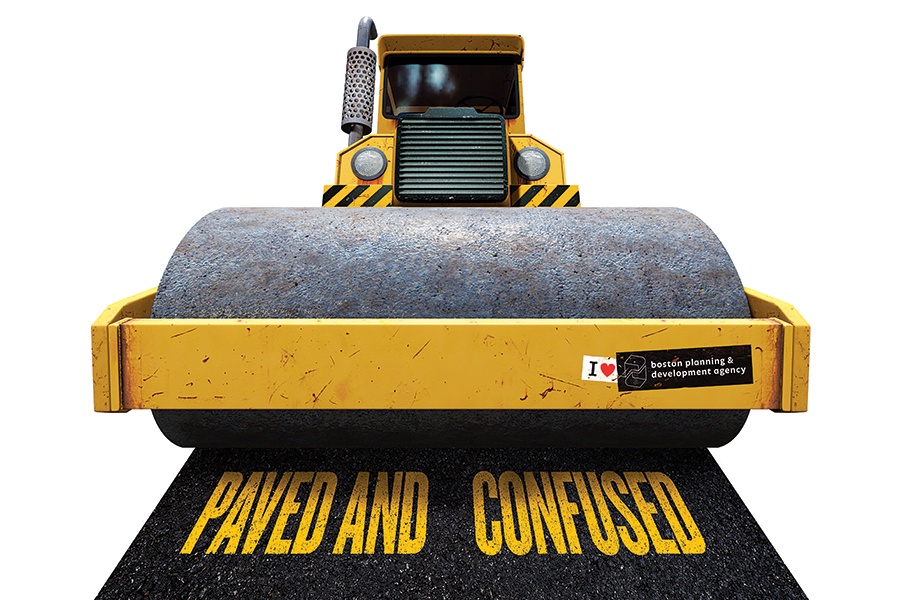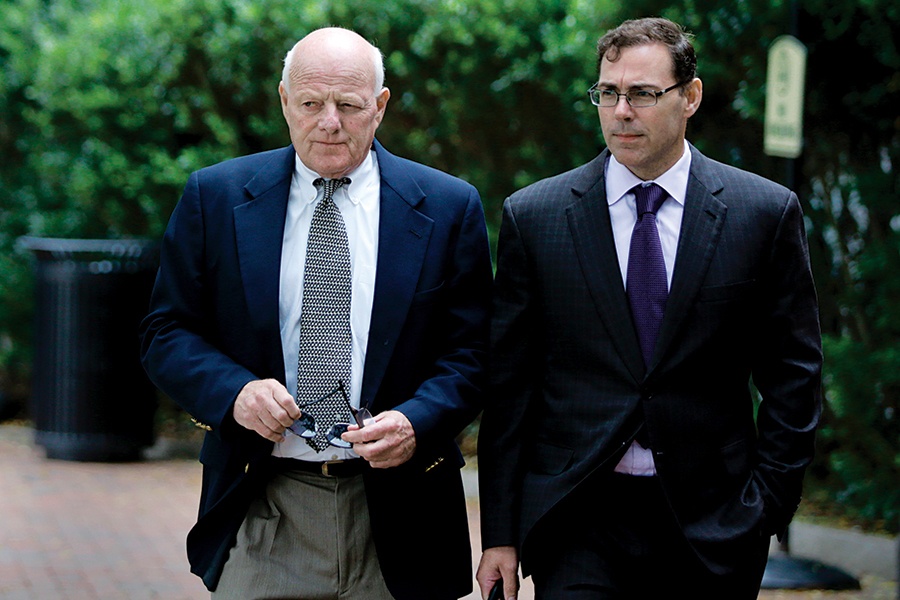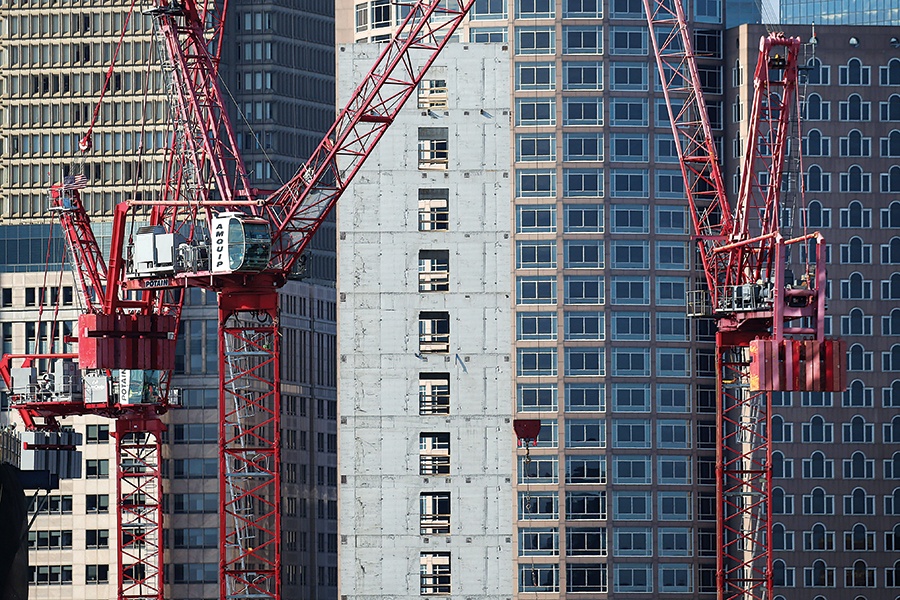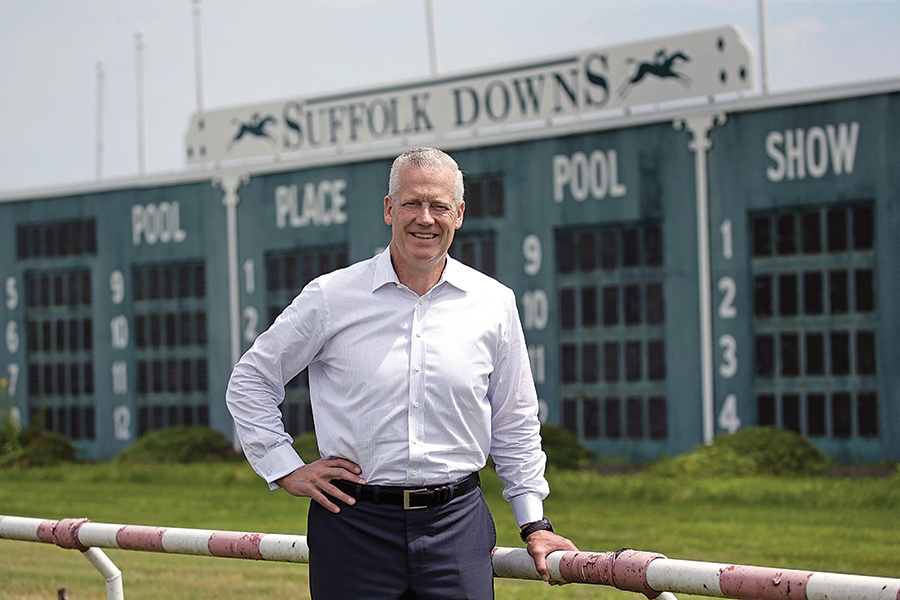The BPDA: Paved and Confused
Snarled traffic. Sky-high rents. And entire neighborhoods that soon may be underwater. Our city planners have steamrolled over communities and failed to build a city that is livable for us all. Is there still a chance to get it right?

Like a scene out of The Departed, a pinched old white man in a black jacket leans across the passenger seat of a car to collect a fan of fresh $100 bills from the driver. It’s such a blatant setup. There’s no envelope. The Benjamins are in full view. The whole choreography of the handoff seems designed to get him in front of a dash cam—instead of a quick drop through the driver’s window, the briber forces the man to reach into the car, his pink face nicely centered in the frame. But John Lynch, the assistant director of real estate at the Boston Planning & Development Agency, doesn’t notice. He is wholly focused on taking what’s his, lips drawn in a taut smile, the crisp new bills within his grasp. In fact, if you look closely at the surveillance photo, he seems relaxed—at ease, even, like he’s done this before.
Across Boston, critics of the city’s billion-dollar real estate bonanza viewed that single 2018 photo of a bribe given and received as indisputable proof that the city still runs by J.M. Curley–style rules. But for those who know how city planning happens here, it was merely the tip of an iceberg of troubles at the BPDA, arguably Boston’s most powerful agency.
Whether or not cash is changing hands, Bostonians should be outraged at how the BPDA functions—or doesn’t. If you think, for instance, that Boston is unaffordable, mired in traffic, and chronically unprepared for climate change, you can mostly blame the BPDA. The city’s entire development process, from zoning to planning to project approval, is controlled by this single agency on the ninth floor of City Hall. In fact, it holds a concentration of power not seen in any other American city, shaping every square inch of our town, yet it is not accountable to the elected members of the city council. Its operations, meanwhile, are plagued by shortsightedness, ineptitude, and misplaced priorities.
This is nothing new. In fact, seven years ago I argued in this magazine that the BPDA (then known as the Boston Redevelopment Authority) had a mission that was so riddled with conflicts of interest that it should be abolished. So why am I at it again? Because despite Mayor Marty Walsh’s promises to reform the agency after audits in 2014 and 2015 revealed that it was a hot mess, not much has changed on the ninth floor since he took office. Worse still, this agency has overseen a larger building boom since 2014 than has ever occurred in a six-year period in Boston since the city was founded in 1630. Over the past decade, the city’s planning agency has systematically squandered a once-in-a-lifetime opportunity to steer well-planned, equitable, and climate-change-ready growth, and has instead focused on a single goal: approving as many projects as quickly as possible.
This build-more, build-fast mindset has had grave consequences. Thousands of high-margin luxury condos have been approved and completed, many of which, bought by entities hidden behind LLCs and shell corporations, sit in unoccupied splendor while driving up the region’s real estate values and costs. The BPDA’s failure to plan, and its deep faith in market forces, has helped balloon the cost of living to the breaking point because everything—from food to payrolls to services—is in one way or another linked to our inflated housing prices. Thousands of Bostonians have been displaced through eviction or aggressive rent increases, and middle-class families are getting pushed farther and farther out of the city, in some cases all the way to New Hampshire. “The agency has lost the trust of the community to carry out the planning process with competence and integrity,” wrote City Councilor at Large Michelle Wu in a recent report demanding the BPDA’s abolition.
Never before has the need to break up the BPDA been more urgent. Right now, the agency is poised to approve the largest private development in its history—millions of square feet at the former Suffolk Downs racetrack. The agency has barreled ahead as if this were just another downtown office tower, aligning with the developer at the expense of the community, and repeating every unforced error that got us to where we are today. Unless the BPDA is abolished before the project breaks ground, Boston will likely lose its last big chance to do development right.

The BPDA’s John Lynch (left) leaves federal court in Boston with his lawyer after pleading guilty to accepting a $50,000 bribe, allegedly from a real estate developer. / Photo courtesy of the Boston Globe via Getty Images

Cranes in full swing over the foundation of 115 Winthrop Square. / Photo courtesy of the Boston Globe via Getty Images
The BPDA announced its arrival in Boston 63 years ago with the roar of an army of bulldozers. Founded to funnel federal money toward urban renewal efforts, the agency, known back then as the Boston Redevelopment Authority (BRA), evicted thousands of minority and immigrant families and razed neighborhoods, including the West End, to make way for office buildings and luxury high-rises.
A seemingly minor tweak in 1987 created the all-powerful BPDA we have today. That year, Mayor Ray Flynn removed the agency from the city budget, arguing it could sustain itself financially using the fees it collects from real estate developers. After that, the agency no longer had to answer to the city council, and ever since then, it has been servile not only to the whims of the mayor, but to the people who keep its lights on: developers.
Walsh’s predecessor, Tom Menino, used the freshly off-the-books agency as the base of his power. To Menino, everything was personal; he made sure that all development decisions went through him, rendering the BRA as little more than a rubber-stamping agency where he could park his political supporters who needed jobs. Not much got built under Menino, but everything that did had his fingerprints all over it.
Walsh ran for mayor in 2013 as a BRA reformer. As a former trade union leader, he also wanted to keep those cranes busy. Once in office, he commissioned an audit that revealed the agency was in shambles. Few staffers, it showed, had any idea what their actual duties were. Records were so shoddy that the BRA didn’t even know what land it owned or what fees and rents were due. Consequently, the city may have failed to collect millions of dollars on leases and linkage fees from developers to fund affordable housing.
Despite grand promises made in the heat of the mayoral campaign, as well as a $675,000 rebranding initiative that included a name change from the BRA to the BPDA, Walsh has done little more than replace the drapes and repaint the house. On the positive side, BPDA head Brian Golden says that 60 percent of staff members are new, and the planning department has grown from 32 to more than 54 employees. He’s hired some multilingual staffers, and employees are learning how to work within Boston’s many different communities. The agency’s overhauled website is easy to navigate and loaded with helpful documents available to the public. The press office is very responsive.
Still, the BPDA’s most problematic features—that it’s beyond city council control and was designed to be developer-responsive rather than planning-oriented—remain locked in place. Most egregiously, unlike many other major American cities—which have laws mandating implementation of a master plan—Boston hasn’t drawn one up since 1965. By law, Philadelphia, Seattle, San Francisco, and Vancouver systematically update their master plans and have clear protocols for incorporating those plans into urban development. In California, by law, master-plan updates must be codified into zoning. The city of Boston doesn’t have a master plan because the BPDA isn’t designed to do that kind of work, and also, possibly, because it would undercut the BPDA’s power. According to BPDA director Golden, Mayor Walsh’s Imagine Boston 2030 initiative—which provides a roadmap for 21st-century growth—is the city’s master plan. Still, the plan lacks teeth because the BPDA has neither the mandate nor the protocols to make it anything more than a wish list.
The BPDA says “nearly one-third of the city’s land is covered either by active or relatively recent planning efforts.” Indeed, the agency’s staffers have conducted community-based “planning” sessions in nearly every neighborhood over the decades. But when a developer brings a project proposal to the ninth floor, there’s no formal mechanism for incorporating what was learned in those planning sessions into the approval process. There are no standardized metrics board members can use to evaluate a project’s value or impact. Instead, the BPDA merely serves as an adviser to the developer, escorting a project through the process while keeping an eye on the clock.
The fact that the agency is partly funded by developers is the fundamental problem, says City Councilor Lydia Edwards. “You shouldn’t be incentivized to develop because your paycheck depends on it,” she says. “You should be incentivized to develop because the city, and the future, and equity depend on it.”
Supporters of the BPDA say Boston’s vocal communities—labeled as NIMBYs—are the single biggest obstacle to progress in the city and that we need an all-powerful planning agency because it is the only way to get anything done in the face of their opposition. In fact, I would argue the opposite is true: Boston’s planning and approval process is so inverted that the BPDA has created the NIMBYs.
By the time a development team arrives in a neighborhood, the BPDA already has skin in the game. The agency’s staff has spent considerable time working with the developer to prep for community meetings, and during this period, the BPDA’s and developer’s interests often align. Armed with inside knowledge, legal expertise, and the mayor’s backing, they make a formidable team. Once the public process begins, communities don’t have much time to react and often feel blindsided by the proposals. They have to scramble to understand their rights, determine what negotiating power they have, and figure out which tools they can use to steer the impact of a project. Lacking the background and unity to negotiate concessions with a powerful developer and the BPDA, many communities resort to outright opposition.
They have good reason to be wary, given that any amenities won by neighbors have historically had a bad habit of disappearing once a project is approved. Case in point: When Millennium Partners bid for the privilege of building 115 Winthrop Square, a $1.3 billion multi-use tower now going up downtown, the developer promised Bostonians a three-story “Great Hall”—a glorious, multifunctional civic space sold as “Boston’s living room,” as well as a space for startups that would be as large as 8,000 square feet. Just three years into the complex process of approving such a large project, Millennium submitted its “notice of project change.” Among the revisions, 100,000 gross square feet of residential space had evaporated. The initial 500 housing unit count had shrunk to 387. Gone were about seven affordable units. Public conference space seemed to disappear. Two grand staircases designed to elevate the look of the Great Hall were obscured by walls. Boston’s living room became a hallway. The startup space was no longer mentioned.
Even the Boston Civic Design Commission (BCDC)—a voluntary board run by some of the city’s finest architects that has the ability to review all large projects in Boston—lacks any statutory power to rein in poorly designed, unwieldy development. As a result, it has scored only a very few small victories in the way of improving projects.
There’s a better way: Plan for growth in a neighborhood before the developer arrives on the scene. Then incorporate that arduous community work into law by updating zoning. Establish which amenities the neighborhood needs and tie those projects to land use. Break planning out of the BPDA and fund it with city money so that it’s accountable to voters. It’s how America’s finest cities handle demand and growth. Why does Boston deserve anything less?

A bird’s-eye view of construction in the Seaport District. / Photo courtesy of the Boston Globe via Getty Images

Activists protest to demand that developers make half of the units at Suffolk Downs affordable housing. / Photo courtesy of the Boston Globe via Getty Images
When Steven Turner allegedly handed all of that cash to Lynch, he owned a one-story South Boston warehouse on a 10th of an acre. Turner knew he could make a pile of dough if he could get a permit extension allowing construction of multifamily housing on that site. So, in exchange for $50,000, Lynch agreed to convince a Boston zoning board member to extend the permit to redevelop the property. Once he secured it, Turner sold the warehouse for a $1.6 million profit in 2018 without developing it. The cost for Turner’s gains will get passed along to condo buyers to the tune of an additional $146,000 per unit. (Turner has not been charged with any wrongdoing.)
Lynch wasn’t the only guy looking to use zoning adjustments to turn a buck. Over the past 15 years, small-time developers have fanned out around South Boston, knocking on doors, offering longtime homeowners loads of money for their triple-deckers. One by one, families have been selling off their homes for huge profits and moving out.
Some developers, like Turner, received permission to build higher than existing zoning allowed. Others did not. That’s why South Boston’s zoning map now looks like a crazy quilt. Single-family and multifamily homes, apartments and condos, and industrial, mixed-use, and institutional buildings are jammed together side by side—the result of hundreds of individual petitions approved by the Zoning Board of Appeal (ZBA).
Perhaps all of this side-dealing would be acceptable if Boston were truly booming. In fact, the city is being crushed under the weight of poorly regulated development geared to enrich a few at the expense of the many. Based on current stats, more than 34,000 households are cost-burdened, meaning that out of every dollar they earn, 50 cents goes to rent or the mortgage. Subtract taxes, and there’s not much left for food. Over the past decade, the number of homeless families in Greater Boston has increased by 27 percent and the number of homeless individuals by 45 percent. A 2020 report by the Metropolitan Area Planning Council revealed that the majority of large units in Greater Boston are occupied by roommates (who can pool resources) or a handful of retirees rattling around in big apartments—not families.
Walsh says he’s concerned, but the one thing he hasn’t been able to confront is Boston’s development machine. And because the mayor would like to have his development and eat it, too, he’s demanding that the BPDA solve Boston’s housing crisis the only way it knows how: by building more.
In the six years that Walsh has been mayor, 18,607 residential units have been built around the city. Sounds good, until you consider that most of them are small and expensive. Notably, more than half of these units are in luxury or ultra-luxury buildings, many of them in the South Boston Waterfront neighborhood. Records show that only a slim majority of all new units built since 2012 are owned by people who claim them as their primary residences. Many were bought by LLCs or shell corporations as a way to park wealth or launder money.
Of course, solving the housing crisis isn’t merely about simple math, and yet the BPDA is still chasing numbers, furiously approving every proposal that comes its way to reach a quota—the mayor wants 53,000 new units built by 2030—without much consideration given to equity. When I met with Councilor Edwards, I repeated the administration’s argument that more housing will eventually satisfy demand.
“Where?” she asked me. When I laughed, she said, “No, I’m serious. Where has that happened? You show me where building a bunch of luxury studios helped house working-class families. You show me where it happened, and I’ll shut up.”
The BPDA argues that we can build our way out of the crisis because when developers need variances (and nearly every project requires a variance because the city’s zoning is so outdated), they must either build affordable units into their projects or pay so-called linkage fees that go into a fund for affordable-housing construction. For example, Jonathan Greeley, BPDA’s director of development review, defends Seaport Square—a huge South Boston Waterfront project—by pointing out that in return for approval, “We got significant investments in…affordable housing, significant investments in the arts, a whole bunch of different things.”
The BPDA’s build-more-to-get-more-affordable-housing argument might make sense at first blush. Over the past decade, developers incorporated 2,983 affordable units into their market-rate projects (though the definition of affordable is up for debate). Other developers paid the one-time fee instead, contributing $93 million to the city’s housing fund. But when you crunch the numbers, you’ll see that $93 million doesn’t buy much in Boston. Over that same decade, federal, state, and city governments have spent an additional $2 billion in Boston to finance 5,286 new affordable units and refurbish existing ones, which cost the city an average of $450,000 a pop.
Based on these figures, it’s clearly more economical for the city to have developers fold affordable housing into new developments or just build for the mid-market than to conjure such housing from scratch via linkage fees. (The latter also further segregates the city, building by building, neighborhood by neighborhood.) For example, if real estate developer Millennium had made 15 percent of its massive new downtown tower affordable, it would have created 66 units. Instead, the developer paid $1.9 million to the city, a sum that, without state and federal subsidies, will cover the cost of only four such units.
Regardless of how affordable units get built, there are consequences to pursuing luxury housing in formerly middle-class neighborhoods. Rampant speculation. Evictions. Aggressive pricing out. Joseph Michalakes, a housing attorney at Greater Boston Legal Services, has worked for several years defending hundreds of families from eviction in East Boston, one of the most recent battlegrounds of development and displacement. Michalakes argues that if projects in Boston continue to be approved “without bringing a fair housing perspective to the planning process, then what we’ve seen happen in East Boston over the past five years, and really longer, is going to keep happening until there’s nowhere left.”
He knows the market-oriented response to people getting priced out: If you can’t afford Boston, then move someplace cheaper. But, he says, “Where is that place? Where are people going to live? People who don’t have a car and make between $20,000 and $50,000 a year, where are they going to go?”

Tom O’Brien, the former director of the BRA, is currently overseeing the development of Suffolk Downs for the HYM Investment Group, where he is the managing director. / Photo courtesy of the Boston Globe via Getty Images
Suffolk Downs may feel like the hinterlands, over there in Eastie beyond the airport. But if you think our traffic is bad now, if you think the cost of living is high now, if you think Boston is the country’s most segregated city now, just wait until our last affordable neighborhood vanishes.
On a freezing January afternoon, I met Councilor Edwards at Maverick Station in East Boston to drive to Suffolk Downs, where we sat in the car and looked over the abandoned racetrack and clubhouse while the winter wind whipped across the vast, open expanse. This is the site where a massive, multi-phase project is slated to be built. Of the 161 acres before us, 122 of them lie in Edwards’s backyard in East Boston, with the remainder in Revere.
For Edwards, the 16-million-square-foot project proposed for the site is a potential threat for the mostly Latinx, renter-heavy, lower-income population that she represents. For local developer HYM Investment Group and 33-year-old Texas billionaire William Bruce Harrison, who together bought the land in 2017 for $155 million, it’s a potential gold mine.
Although the BPDA had plenty of warning that the racetrack was shutting down and was potentially ripe for development, the agency had few thoughts about how this enormous piece of land might be used, or about how development might affect the local community. Those questions were left to the market—or, more specifically, Harrison and Tom O’Brien, HYM’s managing director and a former head of the BRA. They drafted their own plan, complete with new zoning that would allow office, residential, and retail space. Anticipating some pushback, the developer preempted impact fees by proposing that his team pay for some roads and infrastructure improvements. Most of these so-called improvements, however, are streets within the development itself.
So far, the project has been designed like a Houston office park, with chunky buildings looming around a yet-to-be-defined open space, linked by wide streets designed to get cars in and out of the development. It is nothing like Eastie’s existing street grid, in no way resembles the Boston 2030 vision, and certainly looks nothing like the city’s most livable neighborhoods. The project is so inconceivably big that the 65,300 to 76,500 additional vehicle trips per day it’s expected to generate would hopelessly snarl traffic on Route 1A. It’s shocking, opponents of the development argue, that the BPDA has once again escorted the developer through the usual steps, using the standard large-project timeline, without regard for the many serious problems that the project is bound to create.
During a pair of four-month-long public-comment periods in 2019, in fact, objection letters poured into City Hall, many several pages long and carefully crafted by lawyers working for nonprofit advocacy organizations such as Boston Lawyers for Civil Rights. The letters argued that the BPDA did not properly prepare the community, failed to do sufficient outreach in the multiple languages of the community, and, most important, failed to understand the impact this enormous development would have on the people of Eastie, the environment, and Greater Boston. The complaints repeatedly noted that the affordable units being proposed were not affordable enough, large enough, or numerous enough to accommodate even a fraction of those living in the neighborhood who would likely be displaced. Other complaints came from environmental stewards, who warned that raising the land to protect the immediate Suffolk Downs development from flooding would exacerbate drainage issues throughout the surrounding area within a few years.
Leading the charge was Edwards, who invoked the Fair Housing Act of 1968 to demand that the BPDA take concerns about equity more seriously. Appalled at the fast-track approval process and lack of consideration for her vulnerable constituency, she directed her office to draft “Planning for Fair Housing,” a document that details how the city could use planning and zoning to create a better Boston for everyone. The report calls for the BPDA to join the 21st century by embracing “a holistic equity lens in its planning decision” and negotiating “for public interest concessions from development projects to impose fair housing obligations on private developers.”
Although it’s been just three years since HYM and Harrison bought the racetrack, Greeley says the BPDA has put in the necessary work to sign off on the largest private development ever proposed in Boston. “If we were in a rush, which we’re often accused of being,” Greeley says, “we would have done this thing a long time ago. But we’re not. We have slowly, iteratively, tried to figure this out.” In the BPDA’s defense, Greeley adds, “If you were to sit with Tom O’Brien, he’d tell you how many hundreds of meetings [with the community] he’s had.”
Meetings, though, are useless if the two sides are—quite literally—speaking different languages. On February 3, Lawyers for Civil Rights filed a complaint with the Department of Housing and Urban Development against the BPDA, citing the lack of translated materials available to community members with limited English throughout the process. The complaint also asserted that the BPDA, using archaic tools, had failed to properly assess the larger impact on the region. “Suffolk Downs will fundamentally change the character, cost, and composition of every neighborhood it touches and all surrounding communities,” it states. “Simply put, the stakes for affected communities in Boston, who are primarily Limited English Proficiency residents of color, are enormous.” For those reasons, the group requested that the BPDA immediately halt its review process. The BPDA says it did provide the necessary translations required by law, and as of press time, the agency was still formulating a response to the letter, but it continues to usher the project along.
Regardless, the project is so huge and its impacts so unfathomable that it may finally provide city councilors and civil rights advocates with a big enough platform to shine a spotlight on the BPDA’s shortcomings. It seems to be working: Presidential candidate Bernie Sanders tweeted about Suffolk Downs ahead of the March 3 primary, saying, “We need affordable housing for all instead of more gentrifying luxury developments for the few.”
Edwards, for her part, decided that the only way to rein in the BPDA was to change the law. In January, her office submitted a lengthy amendment to the Boston Zoning Code designed to incorporate equity-based impact analyses into the approval process. Her proposed amendment is now going through working sessions in the city council. She admits it may not get passed soon enough to save the city from Suffolk Downs.
In the meantime, the wheels of justice continue to grind away elsewhere in Boston. There was considerable fallout after Lynch was charged with (and later convicted of) bribery involving an organization receiving federal funds and filing a false federal tax return. Though no one else was charged, one member of the Zoning Board of Appeal stepped down after the scandal. In February, Walsh issued an executive order tightening the conflict-of-interest rules for those who sit on the board.
Still, some see Walsh’s response as akin to trying to fix the cracked foundation of a house with paint and spackle. The ZBA isn’t the problem; it is just one feature of a city planning and development structure that is fatally flawed. What Walsh needs to do with the BPDA is what his administration has done best—take a wrecking ball to the old agency and build something shiny and new and modern where it once stood.


